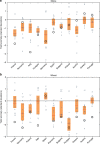State-of-the-art global models underestimate impacts from climate extremes
- PMID: 30824763
- PMCID: PMC6397256
- DOI: 10.1038/s41467-019-08745-6
State-of-the-art global models underestimate impacts from climate extremes
Abstract
Global impact models represent process-level understanding of how natural and human systems may be affected by climate change. Their projections are used in integrated assessments of climate change. Here we test, for the first time, systematically across many important systems, how well such impact models capture the impacts of extreme climate conditions. Using the 2003 European heat wave and drought as a historical analogue for comparable events in the future, we find that a majority of models underestimate the extremeness of impacts in important sectors such as agriculture, terrestrial ecosystems, and heat-related human mortality, while impacts on water resources and hydropower are overestimated in some river basins; and the spread across models is often large. This has important implications for economic assessments of climate change impacts that rely on these models. It also means that societal risks from future extreme events may be greater than previously thought.
Conflict of interest statement
The authors declare no competing interests.
Figures






References
-
- van Vliet MTH, et al. Multi-model assessment of global hydropower and cooling water discharge potential under climate change. Glob. Environ. Chang. 2016;40:156–170. doi: 10.1016/j.gloenvcha.2016.07.007. - DOI
Publication types
LinkOut - more resources
Full Text Sources

